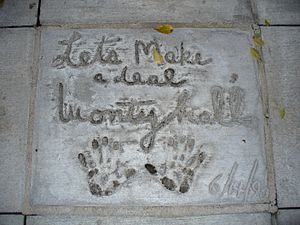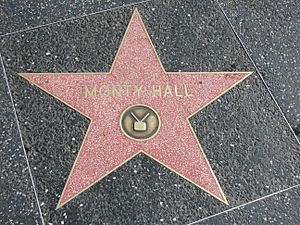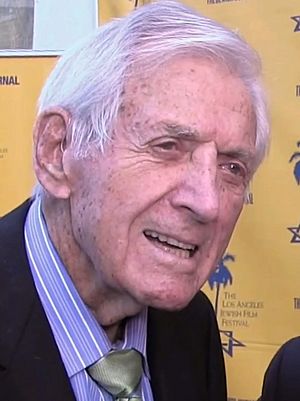Monty Hall facts for kids
Quick facts for kids
Monty Hall
OC OM
|
|
|---|---|

Monty Hall in 1976
|
|
| Born |
Monte Halparin
August 25, 1921 |
| Died | September 30, 2017 (aged 96) |
| Resting place | Hillside Memorial Park Cemetery |
| Alma mater | University of Manitoba (BS) |
| Occupation | Game show host, producer |
| Years active | 1946–2017 |
| Spouse(s) | |
| Children | 3, including Joanna Gleason |
Monty Hall (born Monte Halparin; August 25, 1921 – September 30, 2017) was a famous Canadian TV host and producer. He moved to the United States in 1955 to work in television and radio.
Monty Hall became very well known as the host and producer of the game show Let's Make a Deal. This show started in 1963. He was so famous that a tricky puzzle about chances, called the Monty Hall problem, was named after him. Besides his TV work, Monty Hall also spent a lot of time helping charities.
Contents
Early Life and Education

Monty Hall was born Monte Halparin in Winnipeg, Manitoba, Canada, on August 25, 1921. His parents were Maurice Harvey Halparin and Rose Rusen. He grew up in Winnipeg and went to Lord Selkirk School and then St. John's High School.
He later went to the University of Manitoba. There, he earned a Bachelor of Science degree. He studied chemistry and zoology. A local businessman named Max Freed helped pay for his university studies. Monty Hall had hoped to go to medical school, but he was not accepted.
Television Career
Monty Hall's first job in radio was at CKRC radio in Winnipeg while he was still a student. After finishing university, he worked briefly for the Canadian Wheat Board. But he soon decided to work in broadcasting full-time.
In 1946, he moved to Toronto. He got a job at radio station CHUM. The station managers shortened his name to Hall and accidentally spelled his first name "Monty" on billboards. This is how he got his famous stage name, Monty Hall. For the next ten years, he hosted and produced many radio shows in Toronto. He also had some short TV shows on CBC Television.
In 1955, Monty Hall moved to New York City to try to work in American TV. He hosted game shows like Bingo at Home. He also filled in as a host for popular shows like Strike It Rich and Twenty-One. From 1956 to 1960, he co-hosted a part of the NBC Radio Network show Monitor. He was also a radio announcer for the New York Rangers hockey team in 1959–1960.
He became the host of a game show called Video Village from 1960 to 1962. He also hosted a version for children called Video Village Junior.
Let's Make a Deal
After moving to Southern California, Monty Hall became the host of Let's Make a Deal. He also helped create and produce this show with his partner, Stefan Hatos. Let's Make a Deal became very popular. It aired on NBC from 1963 to 1968 and on ABC from 1968 to 1976. It also ran in syndication (shown on many different channels) for many years.
Monty Hall was the producer or executive producer for most of the show's runs. On the show, he worked with model Carol Merrill and announcer Jay Stewart.
Besides Let's Make a Deal, another successful show from Hatos-Hall Productions was Split Second. Monty Hall hosted a version of Split Second in 1986. He also hosted other game shows like It's Anybody's Guess.
In 2009, CBS brought back Let's Make a Deal. The new show started on October 5, 2009, with Wayne Brady as the host. Monty Hall was a "Creative Consultant" for the show until he passed away in 2017. He also made guest appearances on the show in 2010 and 2013.
Helping Others: Philanthropy
After his main time on Let's Make a Deal, Monty Hall spent a lot of time helping others. He was very involved in charity work. His family said he often went to telethons, which are long TV shows that raise money for good causes. He helped raise almost $1 billion for charity during his life.
Monty Hall was honored many times for his charity work. Parts of Mount Sinai Hospital in Toronto and Hahnemann University Hospital in Philadelphia are named after him.
Awards and Recognition

Monty Hall received a star on the famous Hollywood Walk of Fame in 1973. He also got a Golden Palm Star on the Palm Springs, California, Walk of Stars in 2000. In 2002, he was added to Canada's Walk of Fame.
He is one of only three game show hosts to have stars on both Hollywood's and Canada's Walks of Fame. The others are Alex Trebek and Howie Mandel. In 1988, he was made an Officer of The Order of Canada. This is a very important award for his humanitarian work in Canada and other countries. In 2003, he became a Member of the Order of Manitoba.
In 2005, he received the Ralph Edwards Service Award for his charity work. In 2007, Monty Hall was one of the first people to be added to the American TV Game Show Hall of Fame in Las Vegas, Nevada. He also received a Lifetime Achievement Award at the 2013 Daytime Emmy Awards.
Personal Life
On September 28, 1947, Monty Hall married Marilyn Doreen Plottel. They had three children:
- Joanna Gleason, who became a famous actress and won a Tony Award.
- Sharon Hall Kessler, who is a president at Endemol Shine Studios.
- Richard Hall, an Emmy Award–winning television producer.
Monty and Marilyn lived in Beverly Hills, California, from 1962 until they passed away. Marilyn died in June 2017, just four months before her husband.
Death
Monty Hall passed away from heart failure on September 30, 2017. He was at his home in Beverly Hills and was 96 years old. He was buried at Hillside Memorial Park Cemetery.
The Monty Hall Problem
Monty Hall's name is used in a famous probability puzzle called the "Monty Hall problem". This puzzle is based on a game from Let's Make a Deal.
Here's how the puzzle works:
- Imagine you are on a game show.
- There are three doors. Behind one door is a great prize, like a car. Behind the other two doors are "gag" prizes, like a goat.
- You choose one door, say Door #1.
- The host, "Monty," knows where the car is. He then opens one of the other two doors (Door #2 or Door #3) that you did not pick. He always opens a door that has a goat behind it.
- After showing you a goat, Monty asks you: "Do you want to stick with your first choice, Door #1, or switch to the other unopened door?"
The puzzle asks if you should switch doors. Many people think the chances are 50/50 after one door is opened. However, mathematically, it's better to switch doors! If you switch, you have a 2/3 chance of winning the car. If you stick with your first choice, you only have a 1/3 chance. This is because Monty's action of opening a "goat" door gives you new information.
Monty Hall himself talked about the puzzle in an interview in 1991. He explained that on the actual show, he didn't always follow the strict rules of the puzzle. He could choose whether to offer a switch or not. He might open your door right away if it was a losing door. Or he might offer you money to not switch from a losing door to a winning door. He said, "If the host is required to open a door all the time and offer you a switch, then you should take the switch. But if he has the choice whether to allow a switch or not, beware."
The Monty Hall problem has been mentioned in many TV shows and movies. These include NUMB3RS, 21, Brooklyn Nine-Nine, and the book The Curious Incident of the Dog in the Night-Time. It was also tested on an episode of MythBusters in 2011.
Images for kids
See also
 In Spanish: Monty Hall para niños
In Spanish: Monty Hall para niños






